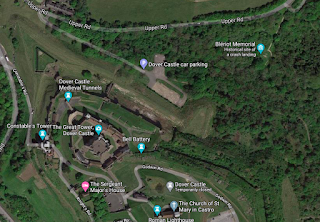Bleriot Crescent
In honour of : Louis Bleriot
Full Real Name : Louis Charles Joseph Bleriot
Born in Cambrai, France on 1st July 1872
Died in Paris, France on 1st August 1936
Bleriot financed his attempts at building aircraft with the invention of the first headlamp for cars which he successfully sold to Renault and Panhard-Levassor.
He initially went into partnership with Voisin and between 1905 and 1906 they built the Bleriot III and IV - both powered by Levavasseur engines and both unsuccessful.
In November 1906 he decided to go it alone and set up Recherches Aeronautiques Louis Bleriot. He successfully designed the world's first powered monoplane.
A tandem winged design followed on and a modified version of the Bleriot VI made a successful flight on 11th July of up 100 feet reaching a height of about 7 feet.
Bleriot went back to his monoplane idea and designed the Bleriot VII from which most modern airplanes take their layout from. This airplane successfully made two 500 metre flights on 6th December.
Following on from this success the Bleriot XII design of a high-wing two seater monoplane flew on 21st May and subsequently made the world's first flight with one passenger on 2nd July and two passengers on 12th July 1909.
Also on 2nd July he made a flight of over 47 minutes at the aviation meet at Douai in the Type XII and then a 50 minute flight in the Type XI at Juvisy.
The Daily Mail had offered a prize of £500 to anyone who could fly across the channel in 1908. Unfortunately no-one managed so they extended it into 1909 and doubled the prize money to £1000. At approximately 4:41 on 25th July Bleriot took off in his Type XI from a farm near Les Baraques, between Calais and Sangatte. Flying at a height of about 250 feet and a speed of 45 mph he set off heading for Dover. He said later:
"for more than 10 minutes I was alone, isolated, lost in the midst of the immense sea, and I did not see anything on the horizon or a single ship."
He had been blown slightly off course but eventually spotted Charles Fontaine waving a large tricolour close to Dover Castle. The flight took 36 minutes and 30 seconds. The film "Those Magnificent Men" is based on the story of this Channel crossing.
This successful flight across the channel brought about commercial success for his company and by the time World War I broke out around 900 airplanes based on the Type XI had been produced.
He set up flying schools at Brooklands and Hendon and the Bleriot Manufacturing Aircraft Company Ltd in 1915 but no orders were forthcoming so the company was closed down again in 1916. However in 1918 he then set up the Air Navigation and Engineering Company (ANEC) in Addlestone which survived until 1926.
In 1927 Bleriot was present at Le Bourget when Lindbergh completed his transatlantic crossing.
Bleriot financed his attempts at building aircraft with the invention of the first headlamp for cars which he successfully sold to Renault and Panhard-Levassor.
He initially went into partnership with Voisin and between 1905 and 1906 they built the Bleriot III and IV - both powered by Levavasseur engines and both unsuccessful.
In November 1906 he decided to go it alone and set up Recherches Aeronautiques Louis Bleriot. He successfully designed the world's first powered monoplane.
A tandem winged design followed on and a modified version of the Bleriot VI made a successful flight on 11th July of up 100 feet reaching a height of about 7 feet.
Bleriot went back to his monoplane idea and designed the Bleriot VII from which most modern airplanes take their layout from. This airplane successfully made two 500 metre flights on 6th December.
Following on from this success the Bleriot XII design of a high-wing two seater monoplane flew on 21st May and subsequently made the world's first flight with one passenger on 2nd July and two passengers on 12th July 1909.
Also on 2nd July he made a flight of over 47 minutes at the aviation meet at Douai in the Type XII and then a 50 minute flight in the Type XI at Juvisy.
The Daily Mail had offered a prize of £500 to anyone who could fly across the channel in 1908. Unfortunately no-one managed so they extended it into 1909 and doubled the prize money to £1000. At approximately 4:41 on 25th July Bleriot took off in his Type XI from a farm near Les Baraques, between Calais and Sangatte. Flying at a height of about 250 feet and a speed of 45 mph he set off heading for Dover. He said later:
"for more than 10 minutes I was alone, isolated, lost in the midst of the immense sea, and I did not see anything on the horizon or a single ship."
He had been blown slightly off course but eventually spotted Charles Fontaine waving a large tricolour close to Dover Castle. The flight took 36 minutes and 30 seconds. The film "Those Magnificent Men" is based on the story of this Channel crossing.
This successful flight across the channel brought about commercial success for his company and by the time World War I broke out around 900 airplanes based on the Type XI had been produced.
He set up flying schools at Brooklands and Hendon and the Bleriot Manufacturing Aircraft Company Ltd in 1915 but no orders were forthcoming so the company was closed down again in 1916. However in 1918 he then set up the Air Navigation and Engineering Company (ANEC) in Addlestone which survived until 1926.
In 1927 Bleriot was present at Le Bourget when Lindbergh completed his transatlantic crossing.
Bleriot congratulating Lindbergh in Paris in 1927
References:
https://www.arts-et-metiers.net/musee/aeroplane-bleriot-xi
https://www.google.co.uk/maps/place/Upper+Rd,+Guston,+Dover/@51.1304506,1.3244015,573m/data=!3m1!1e3!4m5!3m4!1s0x47dea519f41ea46d:0x959ec90d2578418b!8m2!3d51.1328559!4d1.3312545
https://www.wisconsinhistory.org/Records/Image/IM10540
https://www.britannica.com/biography/Louis-Bleriot
https://en.wikipedia.org/wiki/Louis_Bleriot





Comments
Post a Comment